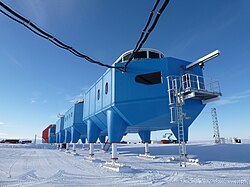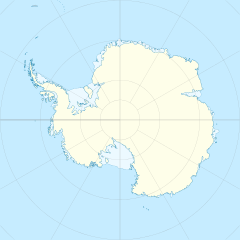Halley Research Station | |
|---|---|
 Halley VI Station | |
Location of Halley within Antarctica | |
| Coordinates: 75°34′05″S 25°30′30″W / 75.568056°S 25.508333°W | |
| Country | |
| British Overseas Territory | British Antarctic Territory |
| Location in Antarctica | Brunt Ice Shelf Caird Coast |
| Administered by | British Antarctic Survey |
| Established | January 15, 1956 |
| Named for | Edmond Halley |
| Elevation | 37 m (121 ft) |
| Population (2017)[1] | |
| • Summer | 70 |
| • Winter | 17 |
| UN/LOCODE | AQ HLY |
| Type | All-year round |
| Period | Annual |
| Status | Operational |
| Activities | List
|
| Website | Halley VI @ bas.ac.uk |
Halley Skiway | |||||||||||
|---|---|---|---|---|---|---|---|---|---|---|---|
| Summary | |||||||||||
| Airport type | Private | ||||||||||
| Location | Halley Research Station Brunt Ice Shelf | ||||||||||
| Coordinates | 75°35′00″S 26°39′36″W / 75.583332°S 26.659999°W | ||||||||||
| Map | |||||||||||
 | |||||||||||
| Runways | |||||||||||
| |||||||||||
Halley Research Station is a research facility in Antarctica on the Brunt Ice Shelf operated by the British Antarctic Survey (BAS). The base was established in 1956 to study the Earth's atmosphere. Measurements from Halley led to the discovery of the ozone hole in 1985.[3] The current base is the sixth in a line of structures and includes design elements intended to overcome the challenge of building on a floating ice shelf without being buried and crushed by snow. As of 2020[update], the base has been left unstaffed through winter since 2017, due to concerns over the propagation of an ice crack and how this might cut off the evacuation route in an emergency.
The Halley Bay Important Bird Area with its emperor penguin colony lies in the vicinity of the base.
- ^ a b Antarctic Station Catalogue (PDF) (catalogue). Council of Managers of National Antarctic Programs. August 2017. p. 139. ISBN 978-0-473-40409-3. Archived (PDF) from the original on 22 October 2022. Retrieved 16 January 2023.
- ^ "Halley Research Station". Great Circle Mapper. Retrieved August 13, 2018.
- ^ "Halley Research Station". British Antarctic Survey. Retrieved 2008-01-13.

